Original article by David Graper, former SDSU Extension Horticulture Specialist and Master Gardener Program Coordinator. Updated by Kristine Lang, Assistant Professor and SDSU Extension Consumer Horticulture Specialist.
Spring and fall are both excellent times to re-evaluate your current gardens and identify spots to incorporate new plants. Do you have any large areas of bare soil in the garden under trees or next to a shaded spot near your home? Consider planting perennial ground covers to fill in extra space in your shady location!
About Ground Covers
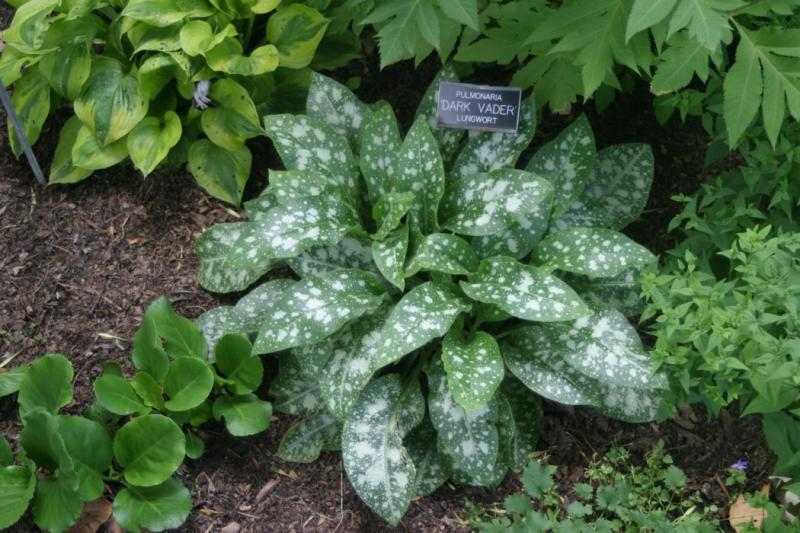
Shady gardens can be filled with plants of various shapes and sizes reaching heights of several feet with eye-catching foliage or blooms. However, ground covers, which are usually twelve inches tall or shorter, are an important component of the shade garden.
Ground cover plants generally serve the following purposes:
- Cover the soil to protect it from erosion by wind or water.
- Shade the soil to reduce the likelihood of undesirable plants to become established.
- Shade the soil to keep it cooler and reduce water loss from it.
- Occupy the soil itself with roots to compete with potentially invasive plants.
- Add beauty and interest to a landscape.
Most ground cover plants will spread out over or in the soil, producing new plants as they grow. Rhizomes are underground stems utilized by some plants, like lily of the valley, while stolons, spreading above ground stems, are produced by other plants, like bugle weed. Grasses and other monocotyledonous plants may also produce rhizomes, stolons, offsets or tillers to expand the territory that they cover. These are all great characteristics for a ground cover to have, particularly in challenging locations, like a hillside that is prone to erosion and needs to stabilization. However, that same propensity to spread can also make many of these plants aggressive competitors with other desirable plants that might also be in the landscape. So, choose your ground cover plants carefully so that you do not end up with a mass planting that is on its way to take over your garden a few years after planting.
Selections for Shady Gardens
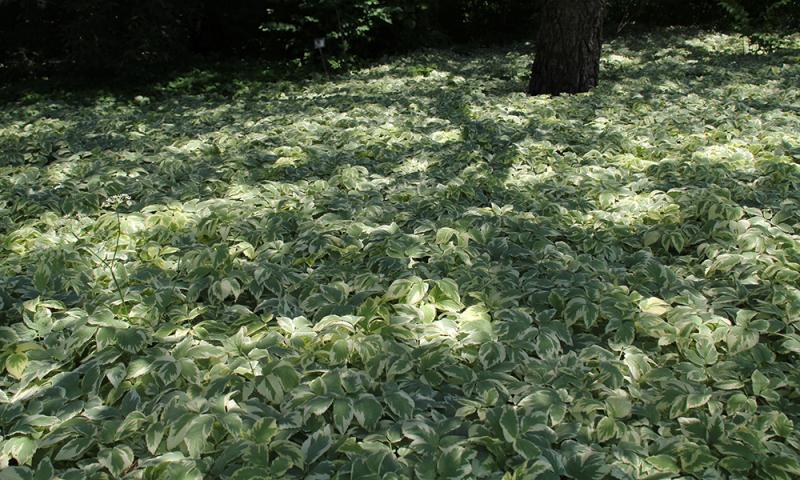
Snow-on-the-Mountain
Snow-on-the-Mountain (Aegopodium podagraria ‘Variegatum’) is one of the toughest ground covers you are going to find. The foliage grows up to about ten inches tall and is usually green variegated with creamy white. In early summer, it shoots up stalks of white flowers that may grow an additional four to six inches above the foliage. In moist shade and in good soil, this plant can rapidly cover large areas of the ground, making it a good alternative to poorly growing grass in some cases. But you had better be careful to keep it in-bounds. If it gets too dry, the leaves may turn a bit brown. Just run the mower over them in mid-summer to see a fresh crop of new foliage spring up in the fall. Snow-on-the-Mountain can grow well in sunnier locations if it has adequate moisture.
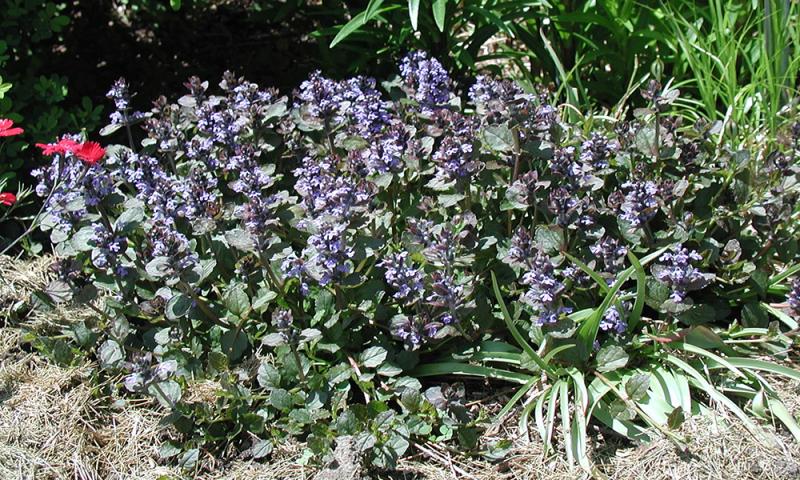
Bugleweed
Bugleweed (Ajuga reptans) is one of the easiest and most reliable ground cover plants to grow. It readily spreads by stolons that grow along the surface of the ground, producing new plantlets that root down and expand their colony of plants. The common name of bugle weed comes from the appearance of the blue, tubular flowers that are borne around the nodes on the six-to-eight inch stems in June. There are several cultivars that have foliage in plain green, burgundy green or variegated with white and pink.
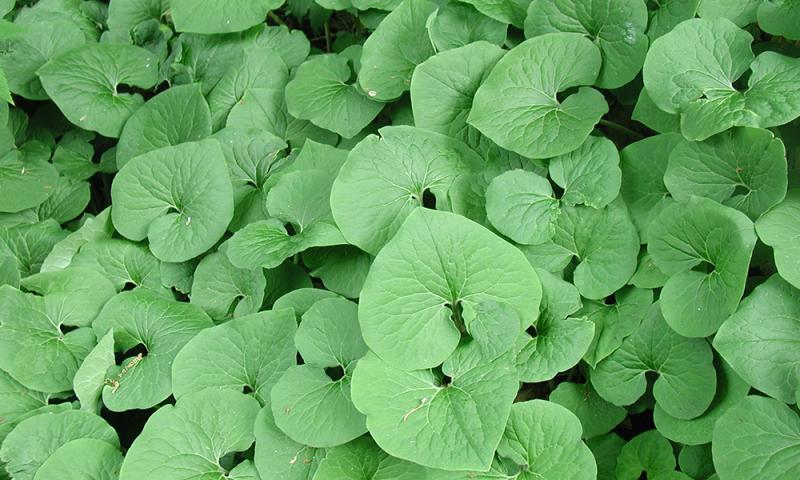
Wild Ginger
Canadian Wild Ginger (Asarum canadense) and European Wild Ginger (Asarum europium) are two very interesting ground cover plants with rounded, heart-shaped leaves and prostrate stems that creep along the ground. One of the easiest ways to tell these two species apart is that Canadian Wild Ginger has slightly hairy leaves and stems, while European Wild Ginger has glossy leaves and stems. The flowers are tubular, about three-quarter inches in diameter, with three pointed petals. They practically lie on the ground to facilitate pollination by ground-dwelling insects. While the stems do have a distinctive gingery aroma, these are not considered to be edible plants.
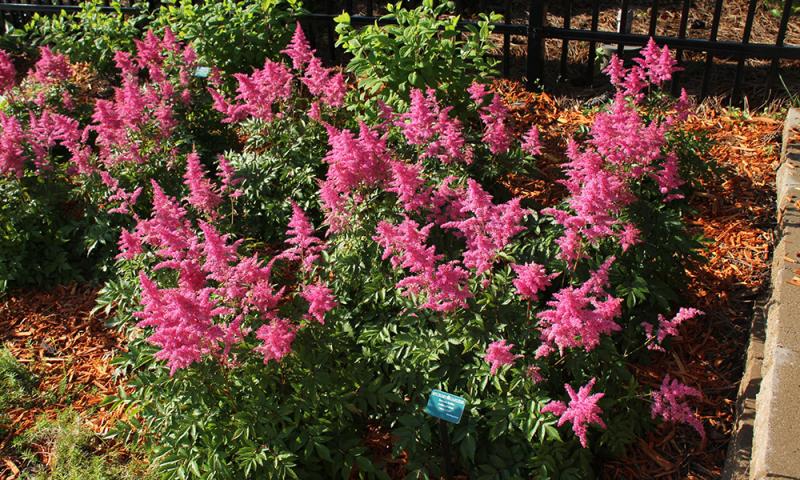
False Spirea
False spirea (Astilbe sp.) is a plant that is adapted to shade to part-sun locations with soils rich in organic matter and a consistent supply of moisture. In early summer, striking, fuzzy-looking flower spikes are produced in colors of white, pink to red. There are many hybrids of Astilbe available in garden centers, so you can incorporate a wide range of blooms in your garden. The ternately compound leaves give a soft appearance in a mass landscape planting, and they are attractive all season long, even after spent blooms have been removed.
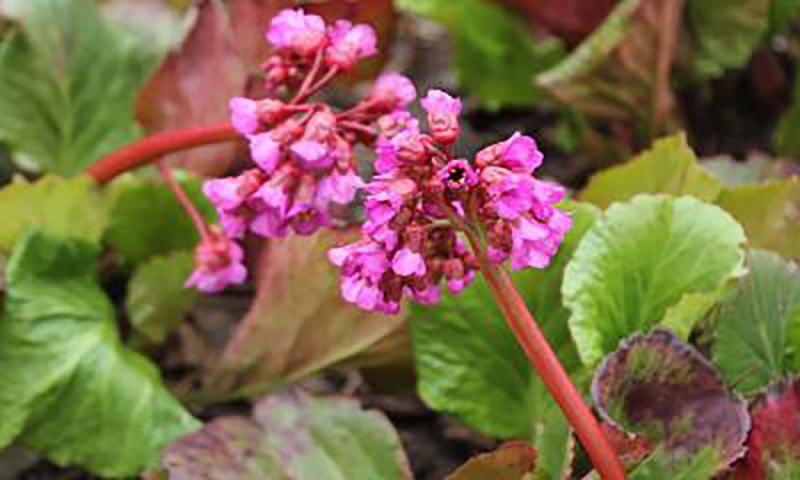
Heart-Leaf Bergenia
Heart-Leaf Bergenia (Bergenia cordifolia) is a great plant for many different types of sites in the garden, performing well in shady locations to full sun, if extra moisture is provided. It looks great as a single specimen plant or planted in groups of five or more. Heart-leaf Bergenia is not invasive, spreading slowly as new basal shoots develop on the plant. Lovely, magenta-pink flowers emerge in early spring at about the same time that new foliage unfurls. The flower color of other varieties can range from white to dark pink. Soon, the leaves spread out to about a foot wide and develop a nice, glossy texture. The genus common name of “Pig Squeak” is derived from the sound the leaves make when rubbed between your fingers. When temperatures cool and days shorten in the fall, the leaves take on a burgundy color. The foliage is very freeze-tolerant, so it will look good all fall. It will persist through the winter, especially if given some mulch or snow cover. In the spring, simply cut back the old leaves to make room for the fresh foliage to emerge.
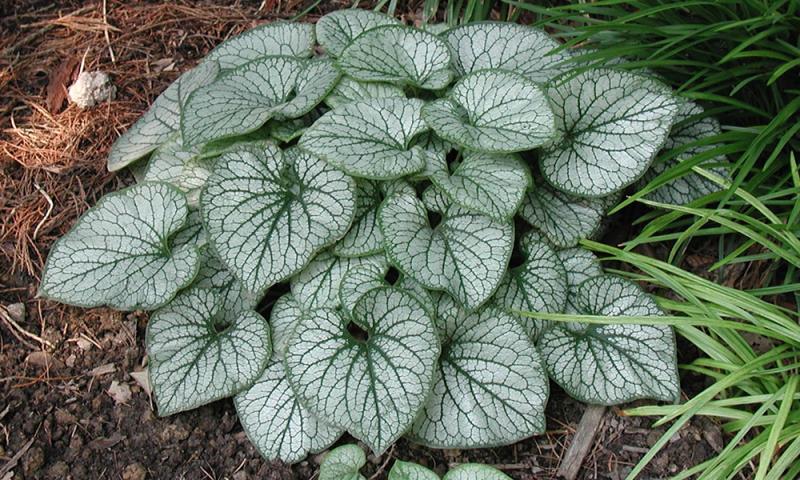
HEARTLEAF BRUNNERA
Heartleaf Brunnera (Brunnera macrophylla) is another great shade garden plant. It grows to about 10 inches tall and 12 inches wide with broad, rounded leaves. The leaves are somewhat heart-shaped, may be plain green, but more likely with speckles or mostly covered with silvery markings with only the small veins remaining green. Heartleaf Brunnera produces small, blue flowers in late spring that are quite delicate and pretty. Its rounded leaves can make a nice contrast to those of hosta, which are usually much more elongated and narrower.
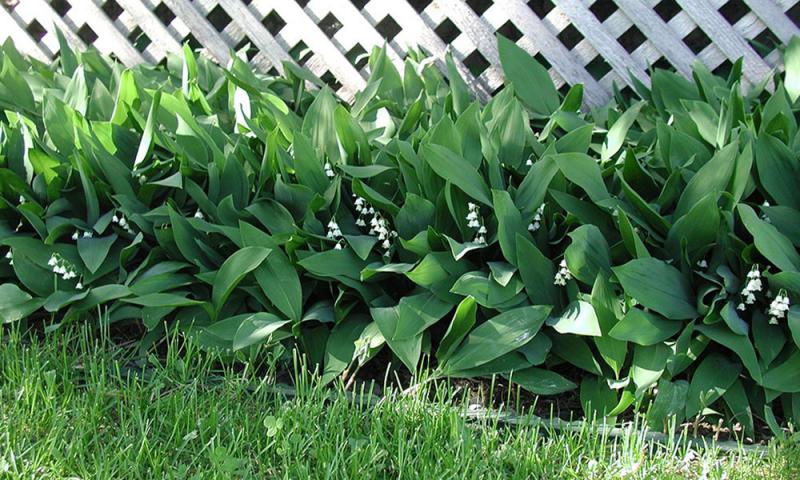
Lily-of-The-Valley
Lily-of-the-Valley (Convallaria majalis) has one of the most sweetly scented flowers of our perennial flowering plants. Each plant usually has only two, or in some cases, three wide, strap-like leaves. A flower stalk grows up through the coiled leaves early in the spring to finally bloom, usually in mid-May. Flowers are usually bright white, but there is at least one cultivar with pink flowers. Lily-of-the-Valley is an aggressive spreader once established, increasing its territory through short rhizomes, called pips, that grow beneath the soil. It will spread out into the lawn, but mowing should keep it knocked back. In some cases, one may want to use some sort of edging that extends about 6” below the soil line to keep it contained. Lily-of-the-Valley will tolerate full sun if it has adequate moisture; otherwise, it may show signs of scorch during hot and dry summer weather. Therefore, a partly shaded to full shade location is preferred.
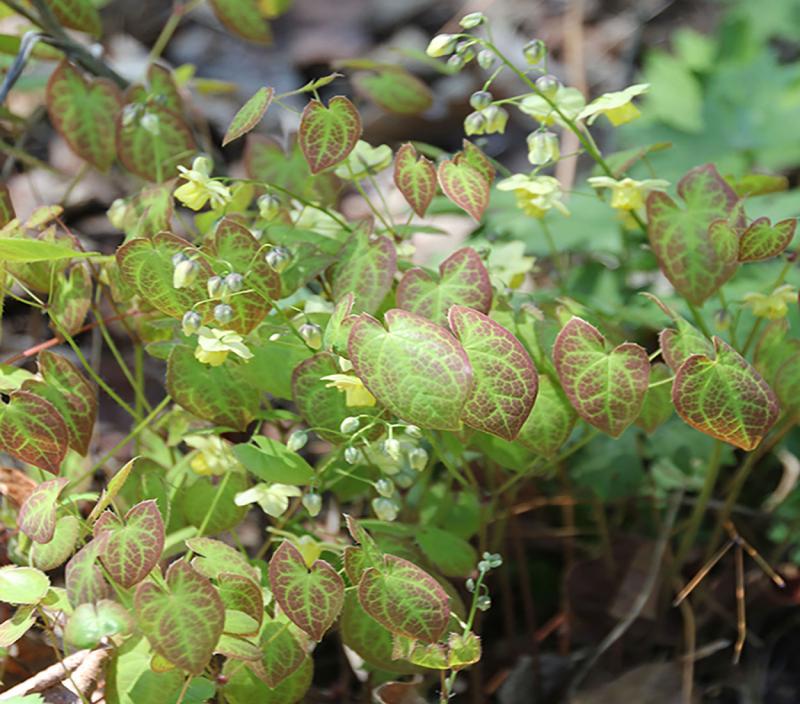
Barrenwort, Bishop’s Hat
Barrenwort (Epimedium sp.) is a little-used perennial that is best adapted to wooded locations, which provide partial sun to shade with a fairly consistent supply of moisture. However, it will grow in dryer locations, just more slowly. In the early spring, often before leaves are fully developed, clusters of four-petaled flowers in white, lavender, pink or yellow emerge, slightly suspended above the foliage. The leaves are two or three times ternate and usually emerge with a maroon coloration along the edges. Some Barrenworts are only hardy to Zone 5 and above, so this plant may not work in all South Dakota gardens.
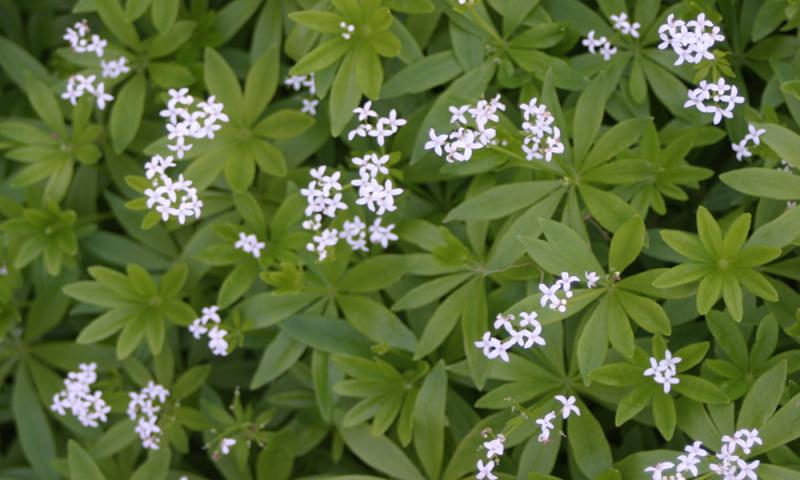
Sweet Woodruff
Sweet Woodruff (Galium odoratum) is a useful ground cover for the partly shaded garden. It has fine, palmately compound leaves and clusters of small, star-shaped flowers in the spring. It spreads nicely in the garden, particularly with a consistent supply of moisture. Once flowering is complete, its foliage looks good the rest of the summer. The leaves emit a sweet fragrance when crushed.
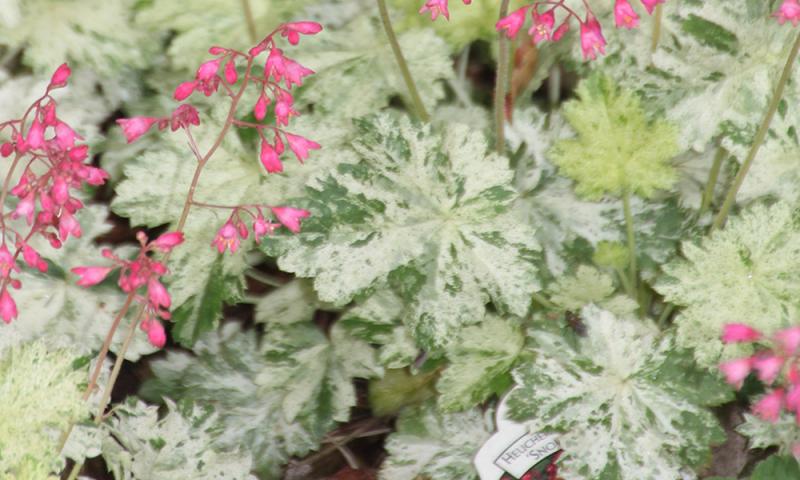
Coral Bells, Foamy Bells and Foam Flower
Coral Bells (Heuchera sanguinea), Foamy Bells (Heucharella) and Foam Flower (Tiarella) are a group of closely-related genera that all fit into about the same niche in the landscape – part shade with a fairly consistent supply of moisture. They are so closely related that they have been frequently used to create intergeneric and interspecific hybrids. While most of these plants are noted for their showy foliage, some have quite attractive flower spikes that range in color from white to pink and red. Generally, they are clump-forming plants that will generally increase in size, so they will look their best when planted in groups of at least five plants.
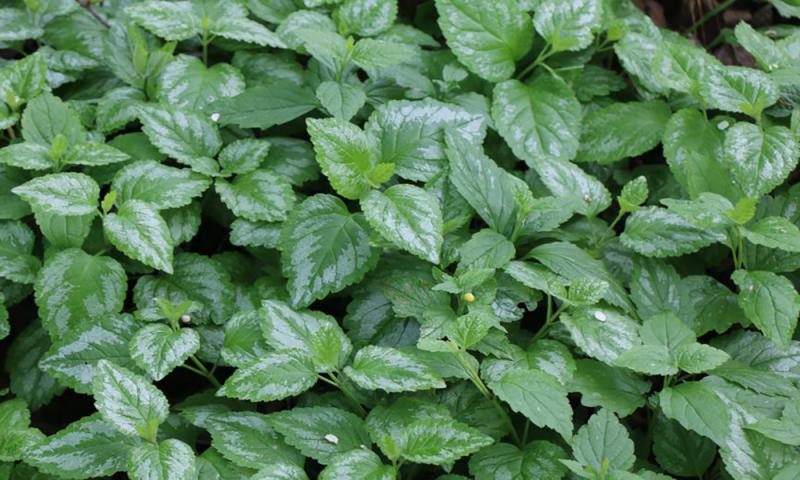
Yellow Archangel
Yellow Archangel (Lamium galeobdolon) is a popular groundcover for shaded areas. The species can be rather aggressive with its quickly growing stems and opposite medium green leaves with silvery markings along the margin. So, be careful where you choose to plant it, so its aggressive nature does not become a problem. A non-spreading cultivar ‘Herman’s Pride’ only grows about eight to twelve inches tall and wide and has similar yellow, tubular flowers to the species.
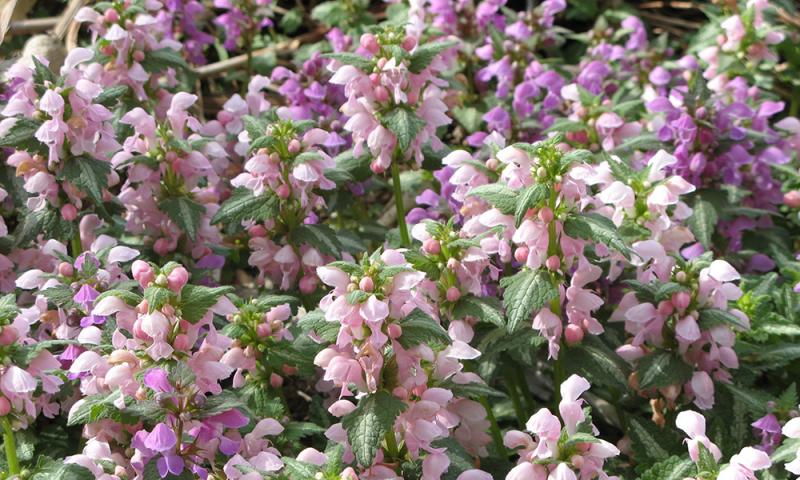
Spotted Nettle
Spotted Nettle (Lamium maculatum) is an excellent ground cover plant that has attractive foliage and pretty flowers that appear in profusion in mid-spring then sporadically over the course of the summer and fall. The leaves are fairly small, about one inch in diameter. They may be plain green, but they are usually spotted or banded in silver-gray. Some varieties have leaves edged in gold-yellow. The flowers are borne in small spikes about six inches tall, and they may be white, pink or lavender. Lamium spreads by creeping stems over the soil, where they will root down and form new plants. It can make a dense ground cover that will hold soil in place and compete fairly well with weeds.

Lungwort
Lungwort (Pulmonaria sp.) is a shade garden “must-have.” It has great-looking foliage from spring to hard freeze and lovely white, pink or lavender flowers in the spring. Lungwort got its name from some early plant geek that thought the leaves looked like diseased lungs – perhaps it is better to remember the botanical name. The leaves of these plants usually have silvery, mottled spots. In some cases, the entire leaf is so covered with spots it just looks silvery-green. Lungwort is about 12 inches tall when in bloom with only small, narrow leaves present along the stem. Then those stems die down while fresh, larger leaves grow up to take their place. Lungworts spread slowly in the garden, eventually forming nice clumps of plants about 12 to 18 inches wide.
Purchasing Perennial Ground Covers
This list did not cover all the plants that make excellent, shade-loving perennial ground covers, so be sure to visit your local garden center for additional options. When selecting perennial ground covers, remember to check that the plant’s hardiness zone matches the conditions where you live. While not all interesting plants may be hardy enough to survive South Dakota winters, there are still many hardy plants to choose from. For additional gardening ideas, visit a botanical garden, such as McCrory Gardens, to get ideas for perennial ground covers for filling in your sunny garden.
References and Resources
- Armitage, A. 2020. Herbaceous Perennial Plants: A Treatise on their Identification, Culture, and Garden Attributes. (4th Ed.) Stipes Publishing. Champaign, IL, USA.
- North Carolina State Extension. North Carolina Extension Gardener Plant Toolbox.


